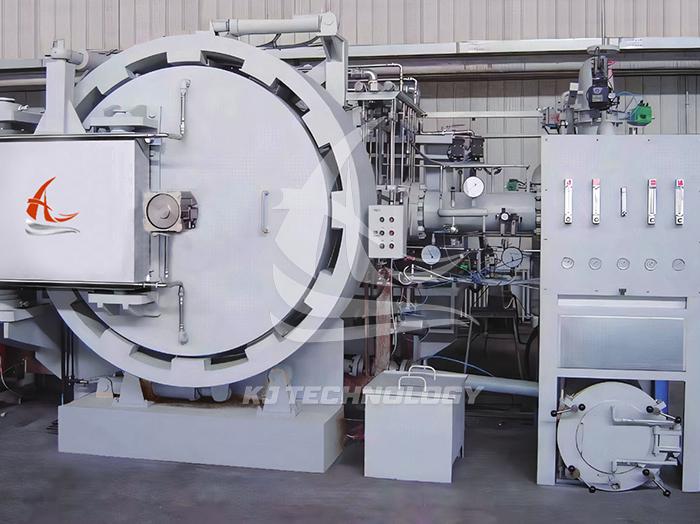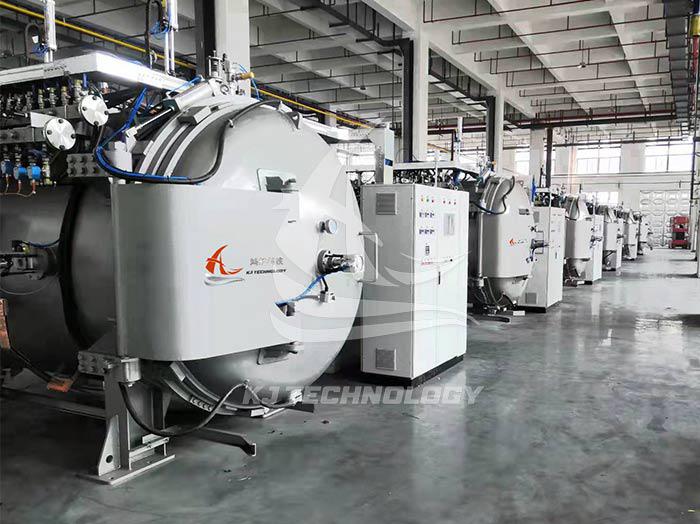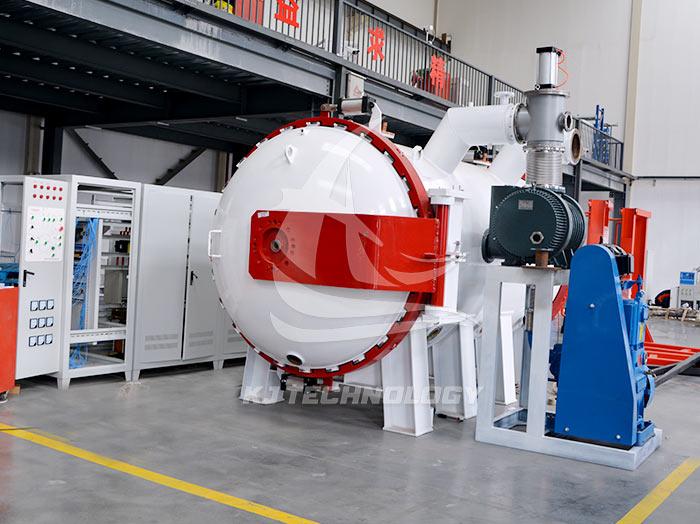Application fields of electric heating vacuum heat treatment furnace
 08-14-2025 Author: KJ technology
08-14-2025 Author: KJ technology
Electric heating vacuum heat treatment furnaces, with their advantages of high vacuum environment, precise temperature control, and pollution-free treatment, are widely used in fields that require strict material performance, covering multiple industries such as aerospace, automotive manufacturing, electronic appliances, energy equipment, medical equipment, and scientific research and education. The following are specific application areas and typical case analyses:
1. Aerospace field
High temperature alloy component treatment
Application scenarios: Annealing, solution treatment, and aging strengthening of key components such as turbine blades, combustion chambers, and guide vanes in aircraft engines.
Technical advantages:
Vacuum environment avoids surface oxidation and carbide segregation of high-temperature alloys (such as Inconel 718, Ren é N5), maintaining material purity.
Accurate temperature control (± 1 ℃) ensures tissue uniformity, improves high-temperature strength (strength retention rate ≥ 95% at 1200 ℃) and creep resistance.
Processing of titanium alloy structural components
Application scenario: Annealing and stress relief treatment of titanium alloys (such as TC4, TA15) for aircraft landing gear, frame, fasteners, etc.
Technical advantages:
The vacuum environment suppresses hydrogen embrittlement, resulting in a hydrogen content of ≤ 0.002% in titanium alloys and a 20% increase in fracture toughness.
Uniform heating reduces deformation and meets the dimensional accuracy requirements of aviation structural components (deformation ≤ 0.05mm).
Preparation of Ceramic Matrix Composite Materials (CMC)
Application scenario: Sintering and connection of hot end components of aircraft engines, such as combustion chamber liners.
Technical advantages:
Vacuum environment avoids oxidation of ceramic materials (such as SiC, Si ∝ N ₄) at high temperatures, maintaining high strength (bending strength ≥ 500MPa) and high temperature resistance (strength retention rate ≥ 80% at 1600 ℃).
The strong connection between ceramics and metals is achieved through active brazing materials such as AgCuTi, with an interface bonding strength of ≥ 150MPa.
2. Automotive manufacturing field
Aluminum alloy component processing
Application scenarios: Solution treatment and aging strengthening of aluminum alloys (such as A356, 6061) for engine cylinder blocks, wheel hubs, heat exchangers, etc.
Technical advantages:
The vacuum environment avoids surface oxidation and overburning of aluminum alloys, maintaining surface smoothness (Ra ≤ 0.8 μ m) and corrosion resistance (salt spray test ≥ 1000 hours).
Accurate temperature control ensures tissue uniformity and improves mechanical properties (tensile strength ≥ 300MPa, elongation ≥ 10%).
Stainless steel exhaust system processing
Application scenarios: Annealing and brightening treatment of stainless steel (such as 409L, 316L) for automotive exhaust manifolds, three-way catalytic converters, etc.
Technical advantages:
Vacuum environment avoids decarburization and chromium oxidation on the surface of stainless steel, maintaining corrosion resistance (neutral salt spray test ≥ 500 hours) and appearance quality (surface roughness Ra ≤ 0.4 μ m).
Uniform heating reduces deformation and meets the sealing requirements of the exhaust system (leakage rate ≤ 0.1%).
Powder metallurgy component sintering
Application scenario: Sintering and densification of powder metallurgy parts such as automotive transmission gears and synchronizer rings (such as Fe-C, Fe-Cu-C).
Technical advantages:
The vacuum environment promotes diffusion and bonding between powder particles, improving density (≥ 98%) and mechanical properties (tensile strength ≥ 800MPa).
Accurate temperature control to avoid overheating or overburning, maintaining dimensional stability (shrinkage rate ≤ 0.1%).
3. Electronic and electrical field
Semiconductor Material Processing
Application scenarios: Annealing and doping activation of semiconductor materials such as silicon wafers, silicon carbide (SiC), gallium nitride (GaN), etc.
Technical advantages:
Vacuum environment avoids surface contamination of materials, maintains high purity (impurity content ≤ 1ppm) and electrical properties (carrier mobility ≥ 1000cm ²/(V · s)).
Accurate temperature control ensures doping uniformity and improves device reliability (failure rate ≤ 1ppm).
Magnetic material processing
Application scenarios: Sintering and heat treatment of neodymium iron boron (NdFeB) permanent magnets, ferrites, and other magnetic materials.
Technical advantages:
Vacuum environment avoids oxidation of magnetic materials and maintains high coercivity and remanence.
Precise temperature control promotes grain refinement and enhances magnetic stability.
Precision connector manufacturing
Application scenarios: Soldering and annealing of precious metal connectors such as gold (Au), silver (Ag), and copper (Cu).
Technical advantages:
Vacuum environment avoids oxidation of precious metals, maintains high conductivity (resistivity ≤ 1.7 × 10 ⁻⁸Ω· m) and welding strength (shear force ≥ 50N).
Accurate temperature control ensures welding quality and improves connector reliability (plug-in life ≥ 10000 times).
4. Energy equipment field
Nuclear power material processing
Application scenarios: Annealing and stress relief of stainless steel (such as 316L, 304L) for nuclear reactor pressure vessels, steam generator heat transfer tubes, etc.
Technical advantages:
Vacuum environment avoids radiation damage to the surface of stainless steel and maintains corrosion resistance.
Precise temperature control reduces residual stress and enhances resistance to stress corrosion cracking.
Wind turbine bearing processing
Application scenario: Spheroidization annealing and stress relief treatment of high carbon chromium bearing steel (such as GCr15) for wind turbine main shaft, gearbox bearings, etc.
Technical advantages:
Vacuum environment avoids decarburization on the surface of bearing steel, maintaining high hardness (HRC60-65) and wear resistance (wear amount ≤ 0.01mm/1000h).
Accurate temperature control promotes carbide spheroidization and improves cutting processability (reducing cutting force by 20%).
Solar cell material processing
Application scenarios: Annealing and doping activation of solar cell materials such as polycrystalline silicon and monocrystalline silicon.
Technical advantages:
Vacuum environment avoids surface contamination of silicon materials, maintaining high purity (impurity content ≤ 0.1ppm) and photoelectric conversion efficiency (≥ 22%).
Accurate temperature control ensures doping uniformity and improves battery cell stability (attenuation rate ≤ 0.5%/year).
5. Medical device field
Biomedical metal material processing
Application scenarios: Annealing and surface gloss treatment of implants such as titanium alloys (such as TC4) and cobalt chromium alloys (such as CoCrMo), such as artificial joints and dental implants.
Technical advantages:
Vacuum environment avoids metal surface contamination, maintains biocompatibility (cytotoxicity test ≤ level 1) and corrosion resistance (simulated body fluid corrosion test ≥ 1000 hours).
Precise temperature control reduces deformation and meets the dimensional accuracy requirements of implants (tolerance ≤ 0.01mm).
Precision machining of medical device components
Application scenario: Annealing and stress relief treatment of stainless steel components such as surgical instruments and endoscopes (such as 316LVM).
Technical advantages:
Vacuum environment avoids surface oxidation of stainless steel, maintaining high smoothness (Ra ≤ 0.2 μ m) and disinfection resistance (high temperature and high pressure disinfection ≥ 1000 times).
Precise temperature control reduces residual stress and improves fatigue resistance (bending fatigue life ≥ 1 million times).
6. In the field of scientific research and education
New material research and development
Application scenario: Universities and research institutes conduct heat treatment experiments on new metal materials (such as high entropy alloys, amorphous alloys) and ceramic materials (such as ZrO ₂, Al ₂ O ∝).
Technical advantages:
The vacuum environment provides high-purity experimental conditions, avoids impurity interference, and ensures the accuracy of experimental data.
Precise temperature control supports complex processes such as gradient annealing and isothermal annealing, meeting the needs of new material research and development.
Case: A certain university successfully prepared a high entropy alloy with a tensile strength of ≥ 2000MPa through a vacuum heat treatment furnace, breaking through the performance limit of traditional materials.
Teaching demonstration and skill training
Application scenario: Vocational colleges conduct practical training on heat treatment technology to cultivate students' vacuum heat treatment operation skills.
Technical advantages:
The device integrates real-time monitoring functions for parameters such as temperature, pressure, and vacuum degree, supporting teaching demonstrations and data analysis.
Provide standard process templates to reduce operational difficulty and improve training efficiency.








